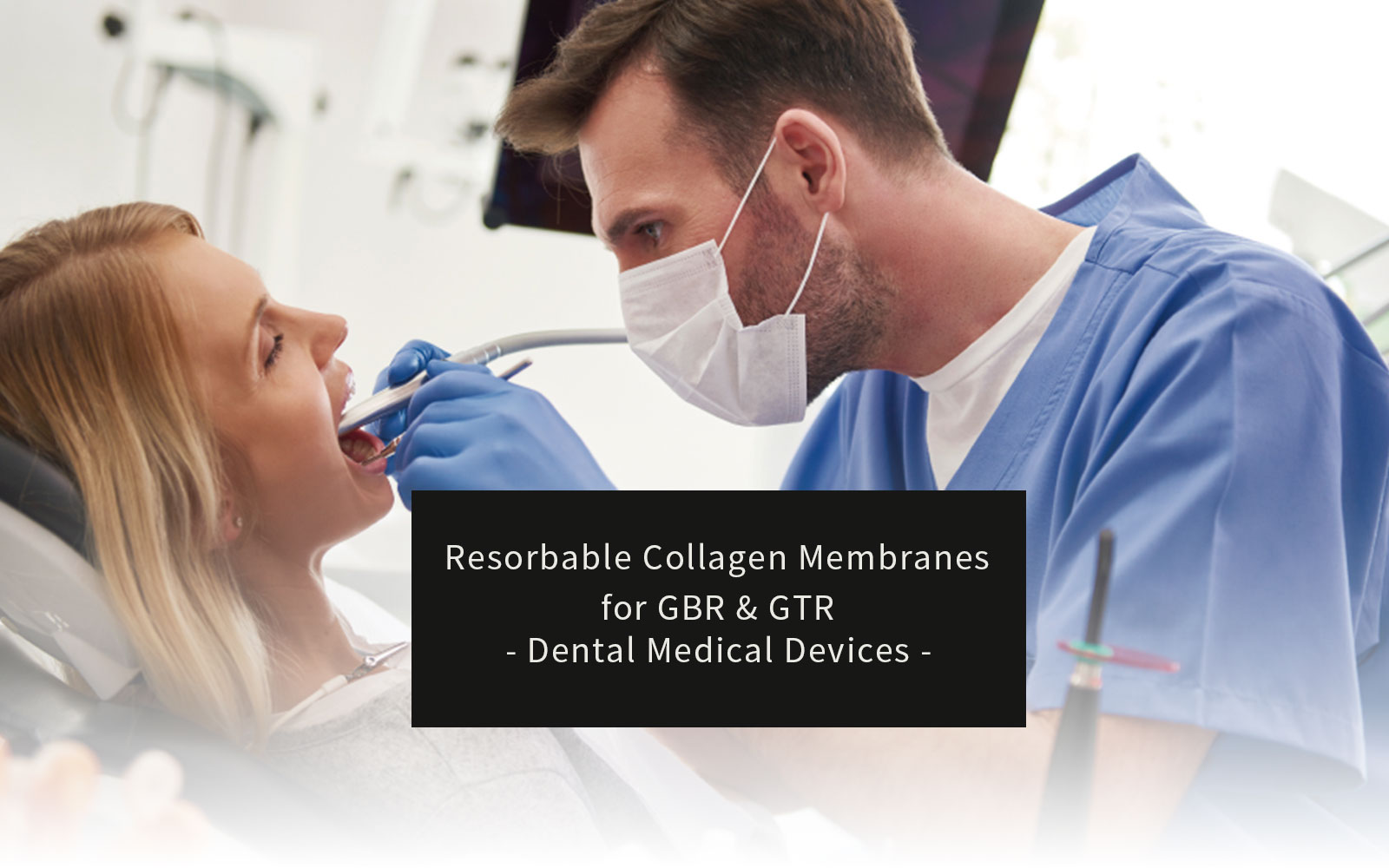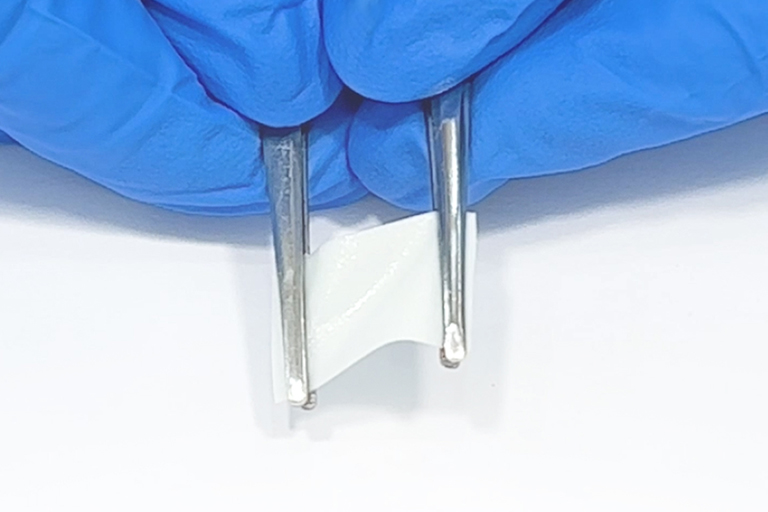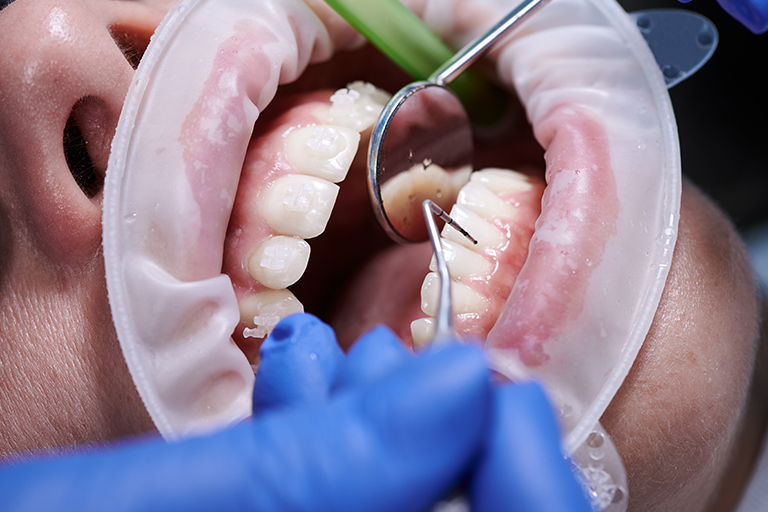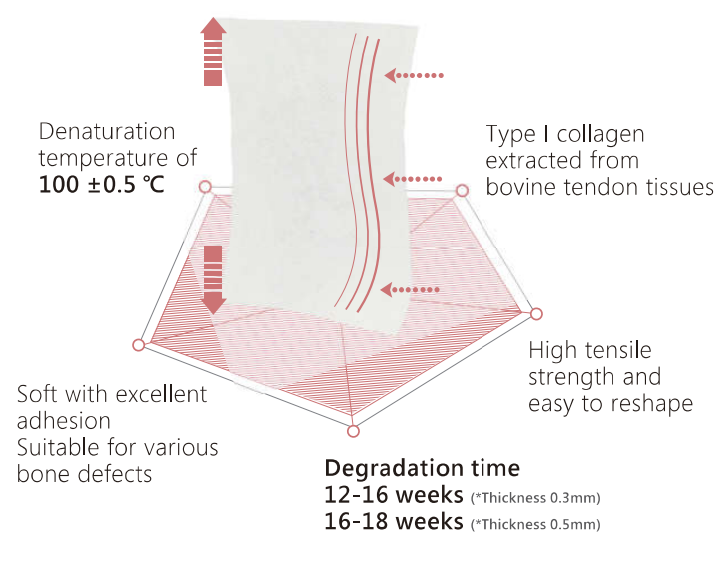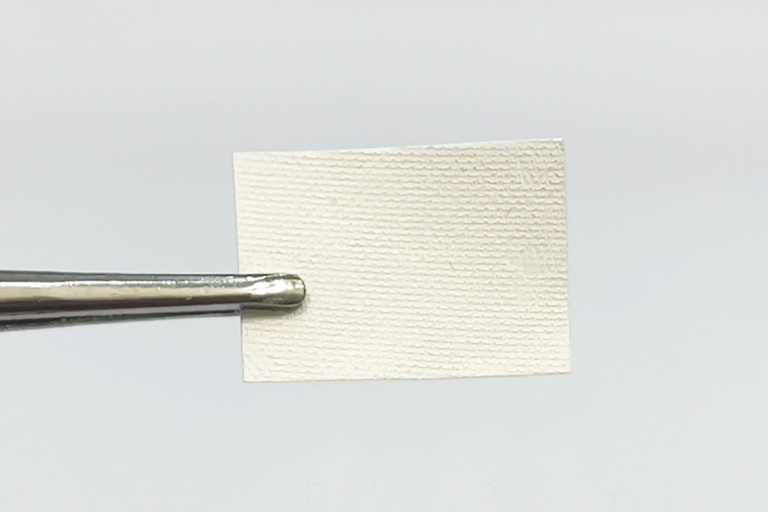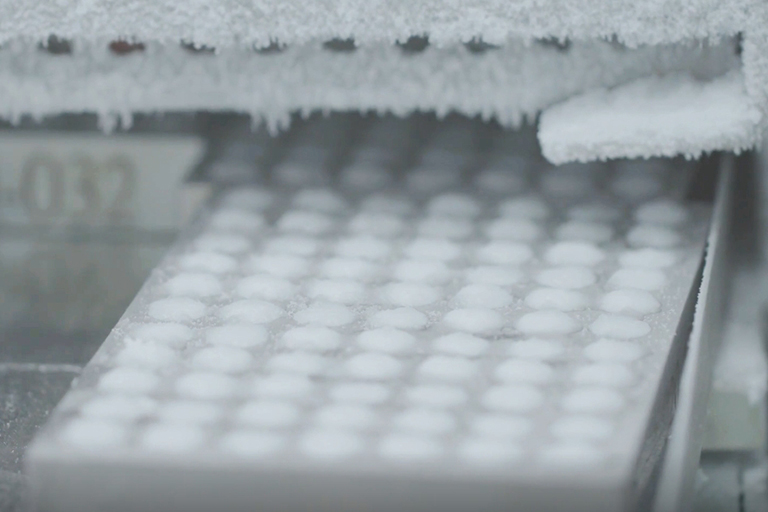Table of Contents
Membranas de barrera utilizadas en odontología
El tratamiento de Regeneración Guiada de Tejidos (GTR) utiliza membranas de barrera oclusivas para excluir el crecimiento descendente relativamente rápido de células epiteliales y fibroblásticas, mientras promueve la repoblación de los sitios defectuosos con células de migración más lenta provenientes del ligamento periodontal, hueso y cemento.
La regeneración ósea guiada (GBR) se desarrolla para la regeneración de defectos óseos basándose en los mismos principios que la GTR, utilizando membranas de barrera para excluir la infiltración de tejido blando en el sitio del defecto y promover la repoblación con células progenitoras osteogénicas.
Membranas reabsorbibles vs. Membranas no reabsorbibles
Tanto las membranas de barrera no absorbibles como las bioabsorbibles han sido desarrolladas y modificadas con el objetivo de ser implantadas sobre el área de defecto tisular para evitar la invasión celular del epitelio gingival y del tejido conectivo.
La membrana no absorbible se utiliza comúnmente para la regeneración tisular a gran escala. La membrana bioabsorbible se basa exclusivamente en polímeros, tanto de material natural como sintético.
Las membranas bioabsorbibles tienen la ventaja de presentar pocas complicaciones y no requieren cirugías secundarias, por lo que se consideran un material de primera elección en el tratamiento de GTR o GBR.
| Barrier membranes | 2nd surgery | Complications | Mechanic Strength | Biocompatibility | Wound Healing |
|---|---|---|---|---|---|
| Resorbable membranes | Not Necessary | Low Risk | Favorable | Good | Promote |
| Non-absorbable membranes | Need | High Risk | High | Good | No work |
Tipos de membranas bioabsorbibles
La membrana bioabsorbible se puede dividir en:
- Material natural
- Material sintético
Las membranas de colágeno reabsorbibles, compuestas por colágeno tipo I o tipo III derivado de bovinos o porcinos, son los materiales más comúnmente utilizados para las membranas de polímero natural.
El quitosano y el alginato también se han introducido para su uso como membranas de barrera en la fase de estudio. Materiales sintéticos como el ácido poliláctico (PLA), el ácido poliglicólico (PGA), el policaprolactona (PCL) y sus copolímeros también se utilizan como membranas de barrera.
El papel de las membranas de colágeno reabsorbibles en los tratamientos de GTR y GBR
El colágeno tiene una excelente biocompatibilidad y capacidad para promover la cicatrización de heridas, y se ha utilizado en diversas aplicaciones médicas, como apósitos para heridas.
En los tratamientos de GTR y GBR, las membranas de colágeno reabsorbibles han demostrado ser comparables a las membranas no absorbibles en cuanto a la reducción de la profundidad de sondaje, la ganancia de inserción clínica y el porcentaje de relleno óseo. Es decir, las membranas de colágeno reabsorbibles son capaces de prevenir el crecimiento epitelial descendente a lo largo de las superficies radiculares durante la fase inicial de cicatrización de heridas y mejorar la generación ósea en defectos óseos al integrarse con material de injerto.
Revolucionando la Regeneración Dental: Maxigen Biotech Inc. (MBI)
Maxigen Biotech Inc. (MBI) se ha dedicado al desarrollo y aplicación de dispositivos médicos a base de colágeno y ácido hialurónico. MBI utiliza su competencia central en biopolímeros y ha desarrollado una amplia gama de aplicaciones biomédicas en áreas como ortopedia, cirugía plástica, manejo de heridas y regeneración dental. En las aplicaciones dentales, la línea de productos de MBI incluye matrices regenerativas basadas en colágeno, como las membranas de GTR/GBR, y sustitutos óseos sintéticos como el compuesto de colágeno/biocerámica.
Por qué la membrana de colágeno reabsorbible es su mejor opción en comparación con otras membranas reabsorbibles
Se han desarrollado varias membranas de colágeno reabsorbibles disponibles comercialmente utilizando colágeno tipo I, como BioGide, BioMend Extend y FormaAid. El colágeno tipo I es un componente predominante en el tejido conectivo periodontal, y el componente de colágeno también posee ventajas adicionales, incluyendo hemostasia, quimiotaxis para los fibroblastos del ligamento periodontal (PDL) y los fibroblastos gingivales, y la capacidad de aumentar el grosor del tejido. Por lo tanto, la membrana de colágeno reabsorbible parece ser una opción ideal para una barrera reabsorbible de GTR o GBR.
El tiempo de reabsorción de la membrana de colágeno reabsorbible
La tasa de degradación de la membrana de colágeno reabsorbible varía según la fuente y el sitio de implantación. Pitaru et al. reportaron una vida media de 21 a 28 días para el colágeno no reticulado cuando se implantó intramuscular o subcutáneamente (ref 1). Sin embargo, no se observó material de colágeno residual sobresaliendo del margen gingival una semana después del tratamiento de defectos de furcación Clase II.
La membrana de barrera ideal debe ser capaz de excluir las células epiteliales no deseadas y mantener un espacio para la repoblación de los sitios defectuosos. Por lo tanto, la barrera debe mantener su integridad estructural durante la fase inicial de cicatrización de heridas. Para este propósito, se han desarrollado varias técnicas de reticulación para prolongar el tiempo de absorción de la membrana de colágeno reabsorbible.
Excelente resistencia a la degradación
MBI FormaAid® presenta un tiempo de degradación excelente de aproximadamente 12 a 18 semanas. A través de un proceso de reticulación física, FormaAid® está diseñado para alinearse adecuadamente con la tasa de regeneración del tejido óseo. Además, exhibe propiedades antidegradación similares en comparación con otras muestras probadas (bioxxx o BioXXX Extend).
Ref. 1: Pitaru S, Tal H, Soldinger M, Grosskopf A, Noff M. Partial regeneration of periodontal tissues using collagen barriers. Initial observations in the canine. J Periodontol 1988;59:380-386.
¿Para qué tipos de procedimientos dentales se utiliza la membrana de colágeno reabsorbible?
Desde finales de la década de 1980, las membranas de colágeno reabsorbibles han sido probadas por su capacidad para promover la regeneración en defectos periodontales intraóseos. Además, se utiliza la membrana de colágeno reabsorbible para promover la regeneración en molares con furcaciones en defectos de furcación Clase II. Recientemente, las membranas de colágeno reabsorbibles se han utilizado en procedimientos de cobertura radicular.
¿Cómo se utiliza la membrana de colágeno reabsorbible para la regeneración ósea guiada (GBR)?
Dado que la membrana de colágeno reabsorbible puede cumplir con los requisitos de una barrera ideal para la regeneración ósea guiada (GBR), incluyendo la estabilización de la herida, la creación y el mantenimiento del espacio, la protección del coágulo de sangre subyacente y la capacidad de excluir tejidos o células no deseadas (es decir, tejido conectivo y epitelio), se ha convertido en uno de los materiales utilizados en los procedimientos de GBR.
¿Cómo se utiliza la membrana de colágeno reabsorbible para la regeneración guiada de tejidos (GTR)?
El colágeno es un componente esencial del hueso y del tejido conectivo y apoya estas estructuras tisulares. Es bien sabido que varias células humanas pueden adherirse fácilmente a la membrana de colágeno, y la membrana de colágeno reabsorbible puede promover la producción de factor de crecimiento de fibroblastos básico (FGF)-2 y proteína morfogenética ósea (BMP)-2 durante la fase de proliferación y migración celular para mejorar el resultado clínico esperado en la aplicación específica. Además, existen varios métodos para modificar aspectos como la microestructura, la porosidad, la resistencia a la hidrólisis o a las enzimas, y la capacidad de sutura de la membrana de colágeno reabsorbible para cumplir con los requisitos clínicos en el procedimiento de GTR.
MBI FormaAid® Membrana de Colágeno GTR con Excelente Elasticidad y Resistencia al Desgarro
La Membrana de Colágeno FormaAid de MBI es una membrana de colágeno reabsorbible fabricada con colágeno fibrilar altamente purificado. La Membrana de Colágeno FormaAid tiene una característica de alta elasticidad sin reticulación química.
Por lo tanto, la Membrana de Colágeno FormaAid® exhibe propiedades ideales, extremadamente adecuadas para su manejo, sutura y funcionalidad como barrera durante los procedimientos de GTR o GBR. La Membrana de Colágeno FormaAid® está indicada para su uso en el tratamiento quirúrgico de defectos periodontales para ayudar en la regeneración e integración de componentes tisulares en procedimientos de GTR o GBR, mejorando la cicatrización de heridas.
Ventajas de MBI FormaAid®
- ¡Soporte de alta resistencia! Preservando la estructura de triple hélice del colágeno con tecnología de entrecruzamiento físico.
- Colágeno natural extraído de tendones de ganado australiano de zonas no epidémicas.
- Colágeno Tipo 1 de alta pureza elaborado con técnicas de purificación patentadas en EE.UU.
- La porosidad y la estructura fibrosa son ideales para la rápida regeneración del tejido.
- Alta resistencia a la tracción y excelente flexibilidad para diversos defectos óseos en entornos clínicos.
- Diversas especificaciones para diferentes tamaños de heridas orales.
¿Cuánto tiempo tarda en disolverse una membrana de colágeno reabsorbible?
Los factores que pueden llevar a la degradación del colágeno incluyen el envejecimiento, las enfermedades o la exposición a la radiación UV. Sin embargo, la principal causa de degradación del colágeno in vivo es la reacción enzimática. Las enzimas principales para la degradación del colágeno son las colagenasas, que pertenecen a un grupo de enzimas llamadas metaloproteinasas de matriz (MMP). Las colagenasas son liberadas principalmente por células inflamatorias, incluyendo macrófagos, neutrófilos y células tumorales.
Por otro lado, el comportamiento de degradación de la membrana de colágeno reabsorbible también dependerá de sus propiedades físicas y químicas, como el proceso de purificación del colágeno, la porosidad de la matriz, el entrecruzamiento químico, etc. En general, el tiempo de degradación de la membrana de colágeno reabsorbible puede variar de semanas a meses.
Posibles efectos secundarios asociados con el uso de la membrana de colágeno reabsorbible:
Actualmente, todas las membranas de colágeno reabsorbibles disponibles están compuestas de colágeno de origen animal, como bovino o porcino. Los pacientes con antecedentes de alergia a cualquier producto de colágeno de origen animal pueden presentar hipersensibilidad. Los signos y síntomas de una reacción alérgica local son dolor (en el sitio de la herida) y enrojecimiento localizado que puede extenderse más allá de los límites del sitio de la herida. Además de las reacciones de hipersensibilidad mencionadas, los efectos secundarios potenciales, como la irritación o el edema, pueden ser causados por el agente de entrecruzamiento químico residual en la membrana de colágeno reabsorbible con entrecruzamiento químico.
La Membrana de Colágeno MBI (FormaAid®) presenta un entrecruzamiento físico, ofreciendo una excelente maniobrabilidad clínica y conformabilidad. Proporciona un amplio tiempo de barrera biológica para guiar el crecimiento del tejido blando, manteniendo así el espacio del hueso alveolar para facilitar la regeneración del tejido óseo. Este enfoque mitiga el riesgo asociado con los agentes de entrecruzamiento químico residual, asegurando un mayor nivel de seguridad y mejorando la biocompatibilidad.
¿Cómo minimizar los posibles efectos secundarios causados por el uso de la membrana de colágeno reabsorbible?
La membrana de colágeno reabsorbible no debe ser utilizada por pacientes con antecedentes de alergia a productos de origen animal. Desde el punto de vista clínico, no se recomienda el uso de membranas de colágeno reabsorbibles en áreas infectadas del sitio de la herida. Desde el punto de vista de fabricación, las membranas de colágeno reabsorbibles con entrecruzamiento químico aumentan el riesgo de una reacción inflamatoria, lo que puede llevar a un manejo complicado de la herida o a una resorción más rápida.
Enfoque Pionero de MBI para Dispositivos Basados en Colágeno y Ácido Hialurónico
Maxigen Biotech Inc., como especialista en la industria de dispositivos médicos, ofrece productos innovadores en cinco disciplinas y cuenta con certificaciones CE, FDA de EE.UU., NMPA y KFDA de los principales países a nivel mundial.
MBI está comprometida en utilizar la ciencia para unir y mejorar la vida humana. MBI se ha dedicado al desarrollo y aplicación de dispositivos médicos de colágeno y ácido hialurónico desde 1998. MBI utiliza su competencia central en biopolímeros y ha desarrollado una amplia gama de aplicaciones biomédicas en áreas como ortopedia, cirugía plástica, manejo de heridas y regeneración dental.
Cada año, más de 3 millones de unidades de dispositivos médicos fabricados por MBI se utilizan en todo el mundo. Únete a MBI para mejorar la vida humana.
El compromiso de MBI con el avance de la atención médica es verdaderamente encomiable. Con una sólida base en la industria de dispositivos médicos dentales y una pasión por mejorar la vida humana, MBI se encuentra a la vanguardia de la innovación. Además de las membranas de colágeno reabsorbibles, como la Membrana de Colágeno FormaAid®, MBI también ofrece tapones de colágeno reabsorbibles, como el Vendaje de Colágeno HealiAid®, que es la mejor opción para la reparación de tejidos blandos orales. Lectura adicional: El Poder Curativo del Vendaje de Colágeno: Una Revisión Integral
¿Cuáles son las principales ventajas de utilizar un tapón de colágeno reabsorbible?
El tapón de colágeno reabsorbible es una matriz de colágeno en forma cilíndrica diseñada para ajustarse en el alvéolo de extracción. Puede proporcionar una estructura para el crecimiento de células periosteales, lo que lo hace adecuado para aplicaciones en la ingeniería de tejidos óseos. Es decir, el tapón de colágeno reabsorbible puede mantener una excelente calidad de cicatrización del alvéolo de extracción para prevenir la reabsorción del hueso alveolar, lo que eventualmente podría causar dificultades clínicas para futuros procedimientos soportados por implantes. Por lo tanto, la preservación del alvéolo utilizando un tapón de colágeno reabsorbible es una estrategia efectiva para mantener el volumen óseo después de la extracción dental.
¿Cuáles son las limitaciones de utilizar un tapón de colágeno reabsorbible?
El vendaje de tapón de colágeno reabsorbible está diseñado como una matriz de colágeno en forma cilíndrica para ajustarse en el alvéolo de extracción, y puede absorber varias veces su propio peso en exudado. Por lo tanto, no se recomienda comprimir la matriz para adaptarla a otros tipos de heridas antes de usarla. Además, no se recomienda utilizar ningún producto de colágeno compuesto de colágeno de origen animal, como bovino o porcino, en pacientes con antecedentes de alergia a productos de colágeno de origen animal.

